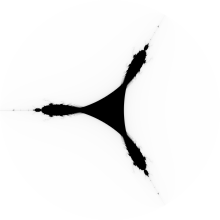Tricorn (mathematics)


In mathematics, the tricorn, sometimes called the Mandelbar set, is a fractal defined in a similar way to the Mandelbrot set, but using the mapping instead of used for the Mandelbrot set. It was introduced by W. D. Crowe, R. Hasson, P. J. Rippon, and P. E. D. Strain-Clark.[1] John Milnor found tricorn-like sets as a prototypical configuration in the parameter space of real cubic polynomials, and in various other families of rational maps.[2]
The characteristic three-cornered shape created by this fractal repeats with variations at different scales, showing the same sort of self-similarity as the Mandelbrot set. In addition to smaller tricorns, smaller versions of the Mandelbrot set are also contained within the tricorn fractal.
Formal definition
The tricorn is defined by a family of quadratic antiholomorphic polynomials
given by
where is a complex parameter. For each , one looks at the forward orbit
of the critical point of the antiholomorphic polynomial . In analogy with the Mandelbrot set, the tricorn is defined as the set of all parameters for which the forward orbit of the critical point is bounded. This is equivalent to saying that the tricorn is the connectedness locus of the family of quadratic antiholomorphic polynomials; i.e. the set of all parameters for which the Julia set is connected.
The higher degree analogues of the tricorn are known as the multicorns.[3] These are the connectedness loci of the family of antiholomorphic polynomials .
Basic properties
- The tricorn is compact, and connected.[4] In fact, Nakane modified Douady and Hubbard's proof of the connectedness of the Mandelbrot set to construct a dynamically defined real-analytic diffeomorphism from the exterior of the tricorn onto the exterior of the closed unit disc in the complex plane. One can define external parameter rays of the tricorn as the inverse images of radial lines under this diffeomorphism.
- Every hyperbolic component of the tricorn is simply connected.[5]
- The boundary of every hyperbolic component of odd period of the tricorn contains real-analytic arcs consisting of quasi-conformally equivalent but conformally distinct parabolic parameters.[6][7] Such an arc is called a parabolic arc of the tricorn. This is in stark contrast with the corresponding situation for the Mandelbrot set, where parabolic parameters of a given period are known to be isolated.
- The boundary of every odd period hyperbolic component consists only of parabolic parameters. More precisely, the boundary of every hyperbolic component of odd period of the tricorn is a simple closed curve consisting of exactly three parabolic cusp points as well as three parabolic arcs, each connecting two parabolic cusps.[8]
- Every parabolic arc of period k has, at both ends, an interval of positive length across which bifurcation from a hyperbolic component of odd period k to a hyperbolic component of period 2k occurs.
Further Topological Properties
The tricorn is not path connected.[9] Hubbard and Schleicher showed that there are hyperbolic components of odd period of the tricorn that cannot be connected to the hyperbolic component of period one by paths.
It is well known that every rational parameter ray of the Mandelbrot set lands at a single parameter.[10][11] On the other hand, the rational parameter rays at odd-periodic (except period one) angles of the tricorn accumulate on arcs of positive length consisting of parabolic parameters.[12]
References
- ↑ http://iopscience.iop.org/article/10.1088/0951-7715/2/4/003/meta;jsessionid=C9B611C5CF44A8CE77C7344996DADD0C.c1
- ↑ http://projecteuclid.org/euclid.em/1048709112
- ↑ http://www.worldscientific.com/doi/abs/10.1142/S0218127403008259
- ↑ http://journals.cambridge.org/action/displayAbstract?fromPage=online&aid=2144300&fileId=S0143385700007409
- ↑ http://www.worldscientific.com/doi/abs/10.1142/S0218127403008259
- ↑ http://www.math.cornell.edu/~hubbard/tricorns.pdf
- ↑ https://www.cambridge.org/core/journals/ergodic-theory-and-dynamical-systems/article/on-multicorns-and-unicorns-ii-bifurcations-in-spaces-of-antiholomorphic-polynomials/3CAEB11B11FB5E3BE1FB5E69E3D5433E
- ↑ https://www.cambridge.org/core/journals/ergodic-theory-and-dynamical-systems/article/on-multicorns-and-unicorns-ii-bifurcations-in-spaces-of-antiholomorphic-polynomials/3CAEB11B11FB5E3BE1FB5E69E3D5433E
- ↑ http://www.math.cornell.edu/~hubbard/tricorns.pdf
- ↑ https://eudml.org/doc/82336
- ↑ http://arxiv.org/pdf/math/9905169.pdf
- ↑ "Non-landing parameter rays of the multicorns". Inventiones mathematicae. 204: 869–893. doi:10.1007/s00222-015-0627-3.